BHP Billiton Employee Turnover Report
VerifiedAdded on 2019/11/20
|25
|5278
|332
Report
AI Summary
This report investigates the relationship between BHP Billiton's health and safety procedures and employee turnover. Using quantitative research methods and secondary data from Statista, the report analyzes employee numbers across different regions from 2012-2017. Descriptive statistics, correlation analysis, and simple linear regression were employed using SPSS. The findings reveal no significant correlation between employee numbers across regions, suggesting potential negative impacts of safety measures on employee retention. The report concludes with recommendations for BHP Billiton to improve its health and safety procedures to enhance employee satisfaction and retention.
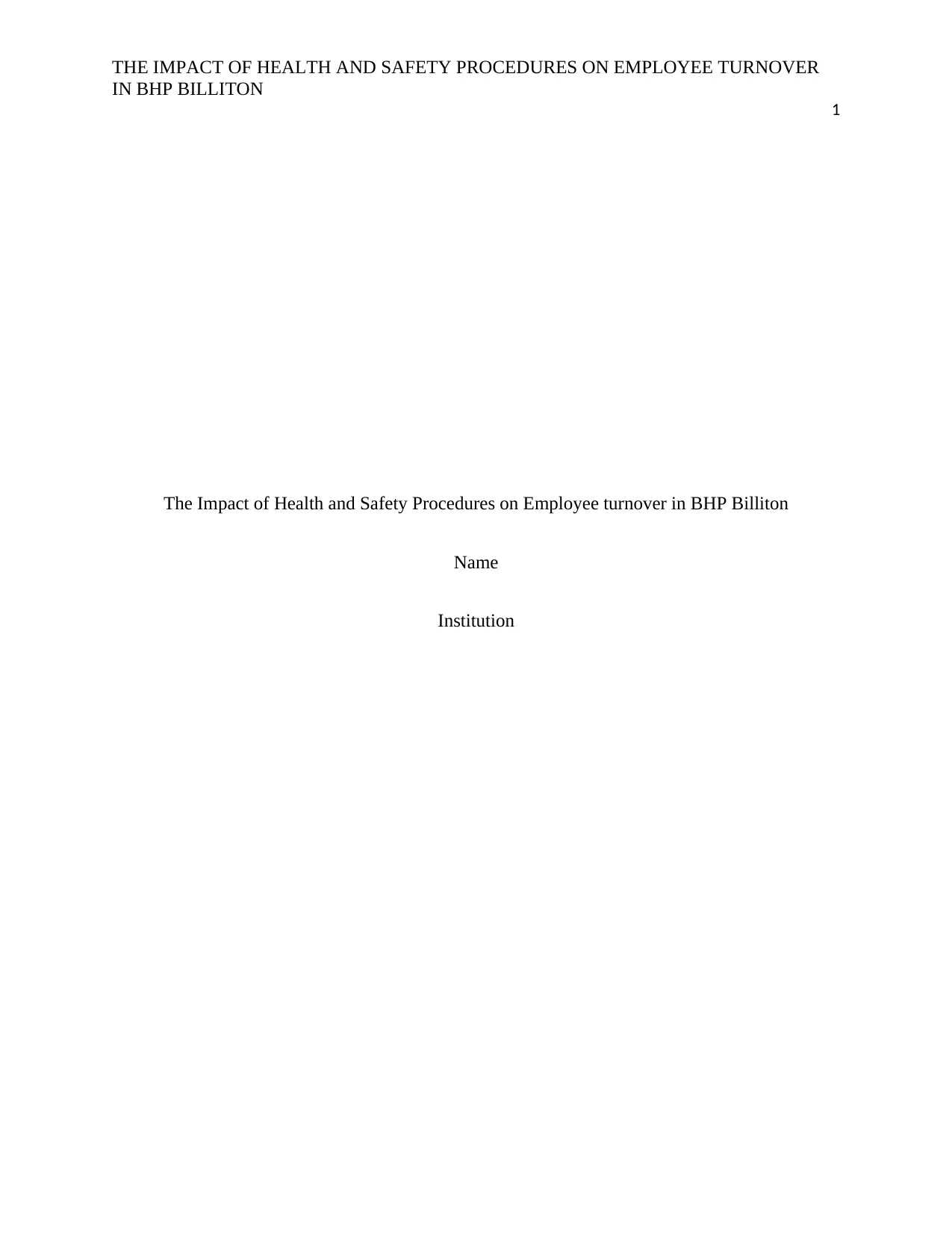
THE IMPACT OF HEALTH AND SAFETY PROCEDURES ON EMPLOYEE TURNOVER
IN BHP BILLITON
1
The Impact of Health and Safety Procedures on Employee turnover in BHP Billiton
Name
Institution
IN BHP BILLITON
1
The Impact of Health and Safety Procedures on Employee turnover in BHP Billiton
Name
Institution
Paraphrase This Document
Need a fresh take? Get an instant paraphrase of this document with our AI Paraphraser
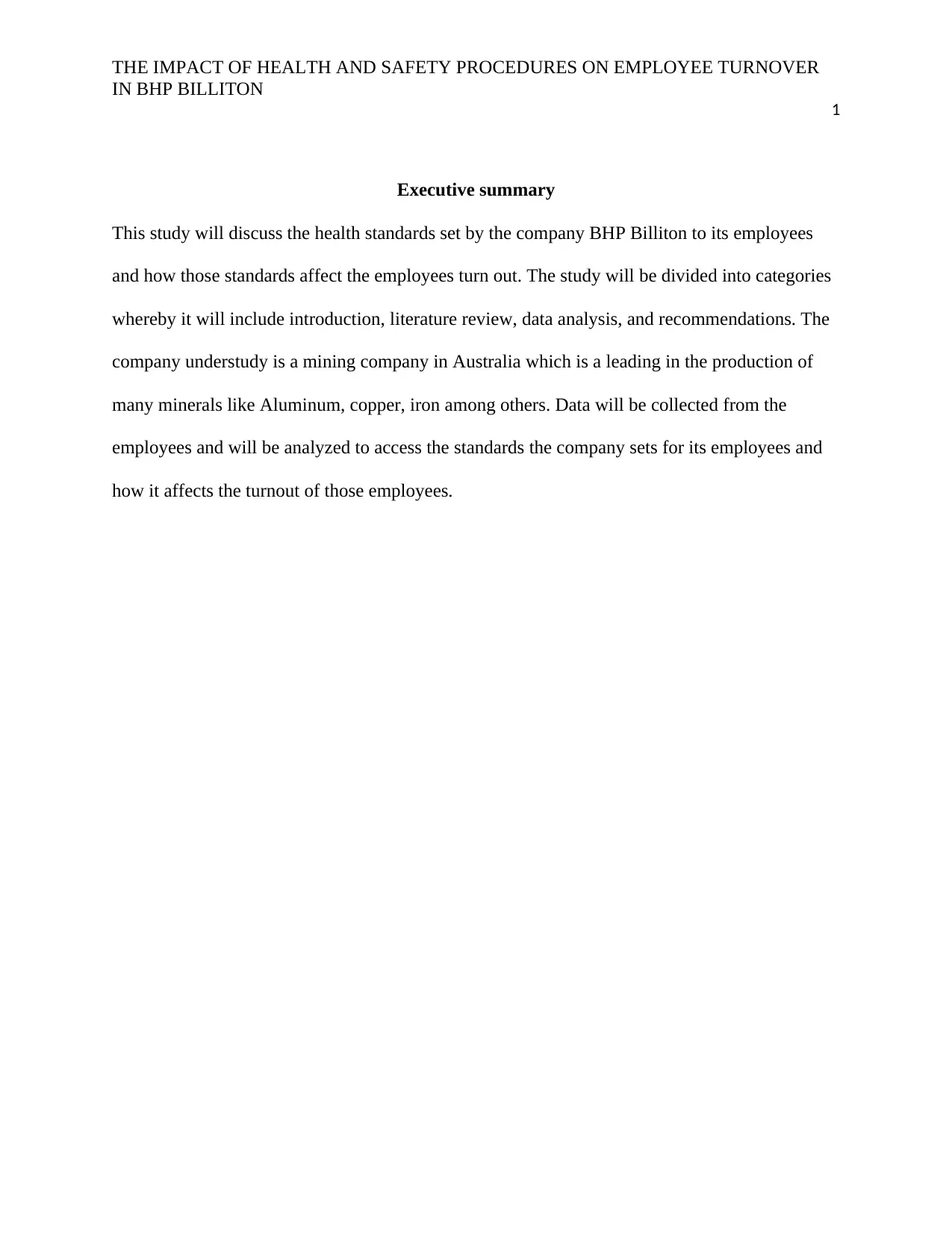
THE IMPACT OF HEALTH AND SAFETY PROCEDURES ON EMPLOYEE TURNOVER
IN BHP BILLITON
1
Executive summary
This study will discuss the health standards set by the company BHP Billiton to its employees
and how those standards affect the employees turn out. The study will be divided into categories
whereby it will include introduction, literature review, data analysis, and recommendations. The
company understudy is a mining company in Australia which is a leading in the production of
many minerals like Aluminum, copper, iron among others. Data will be collected from the
employees and will be analyzed to access the standards the company sets for its employees and
how it affects the turnout of those employees.
IN BHP BILLITON
1
Executive summary
This study will discuss the health standards set by the company BHP Billiton to its employees
and how those standards affect the employees turn out. The study will be divided into categories
whereby it will include introduction, literature review, data analysis, and recommendations. The
company understudy is a mining company in Australia which is a leading in the production of
many minerals like Aluminum, copper, iron among others. Data will be collected from the
employees and will be analyzed to access the standards the company sets for its employees and
how it affects the turnout of those employees.
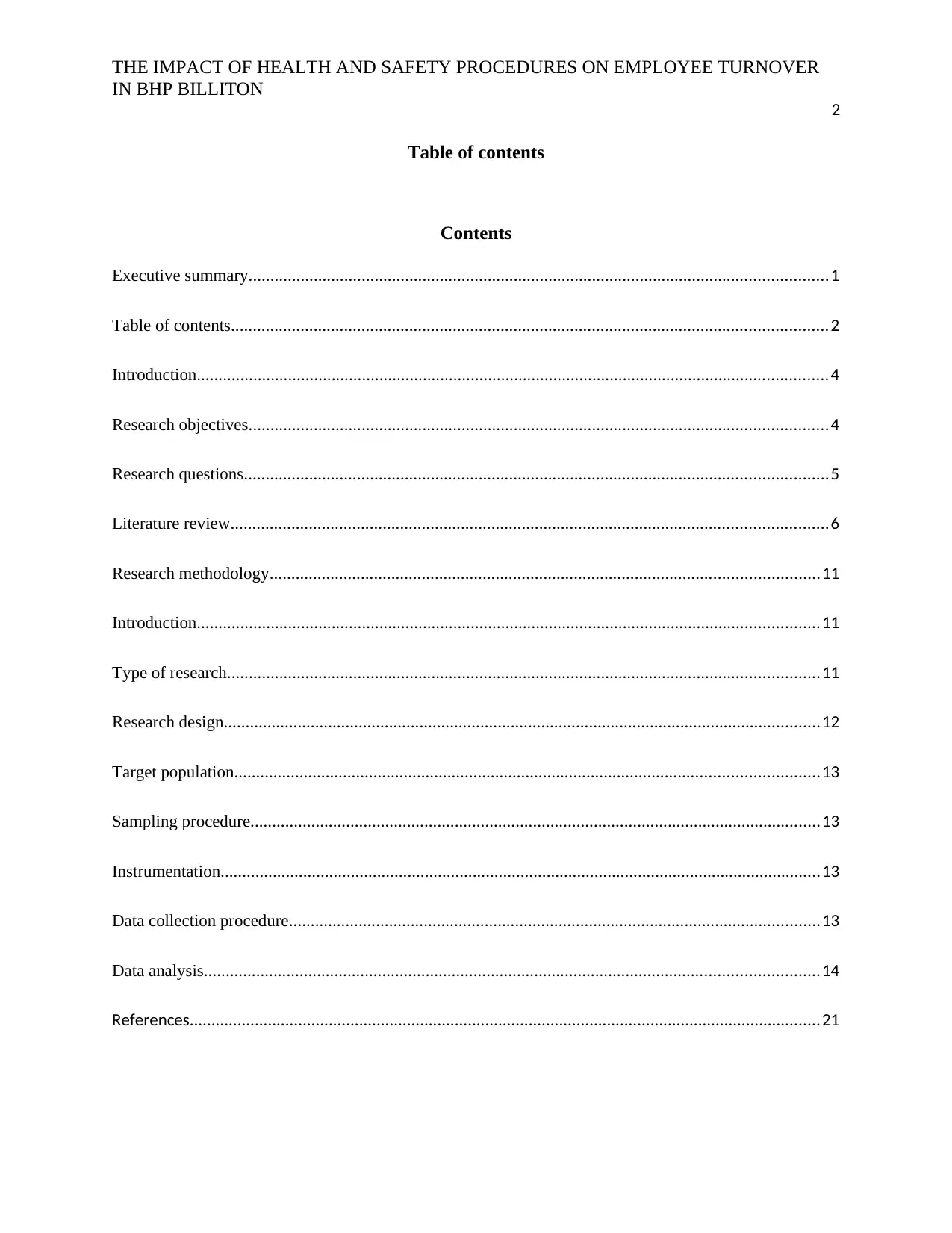
THE IMPACT OF HEALTH AND SAFETY PROCEDURES ON EMPLOYEE TURNOVER
IN BHP BILLITON
2
Table of contents
Contents
Executive summary.....................................................................................................................................1
Table of contents.........................................................................................................................................2
Introduction.................................................................................................................................................4
Research objectives.....................................................................................................................................4
Research questions......................................................................................................................................5
Literature review.........................................................................................................................................6
Research methodology..............................................................................................................................11
Introduction...............................................................................................................................................11
Type of research........................................................................................................................................11
Research design.........................................................................................................................................12
Target population......................................................................................................................................13
Sampling procedure...................................................................................................................................13
Instrumentation..........................................................................................................................................13
Data collection procedure..........................................................................................................................13
Data analysis.............................................................................................................................................14
References.................................................................................................................................................21
IN BHP BILLITON
2
Table of contents
Contents
Executive summary.....................................................................................................................................1
Table of contents.........................................................................................................................................2
Introduction.................................................................................................................................................4
Research objectives.....................................................................................................................................4
Research questions......................................................................................................................................5
Literature review.........................................................................................................................................6
Research methodology..............................................................................................................................11
Introduction...............................................................................................................................................11
Type of research........................................................................................................................................11
Research design.........................................................................................................................................12
Target population......................................................................................................................................13
Sampling procedure...................................................................................................................................13
Instrumentation..........................................................................................................................................13
Data collection procedure..........................................................................................................................13
Data analysis.............................................................................................................................................14
References.................................................................................................................................................21
⊘ This is a preview!⊘
Do you want full access?
Subscribe today to unlock all pages.

Trusted by 1+ million students worldwide
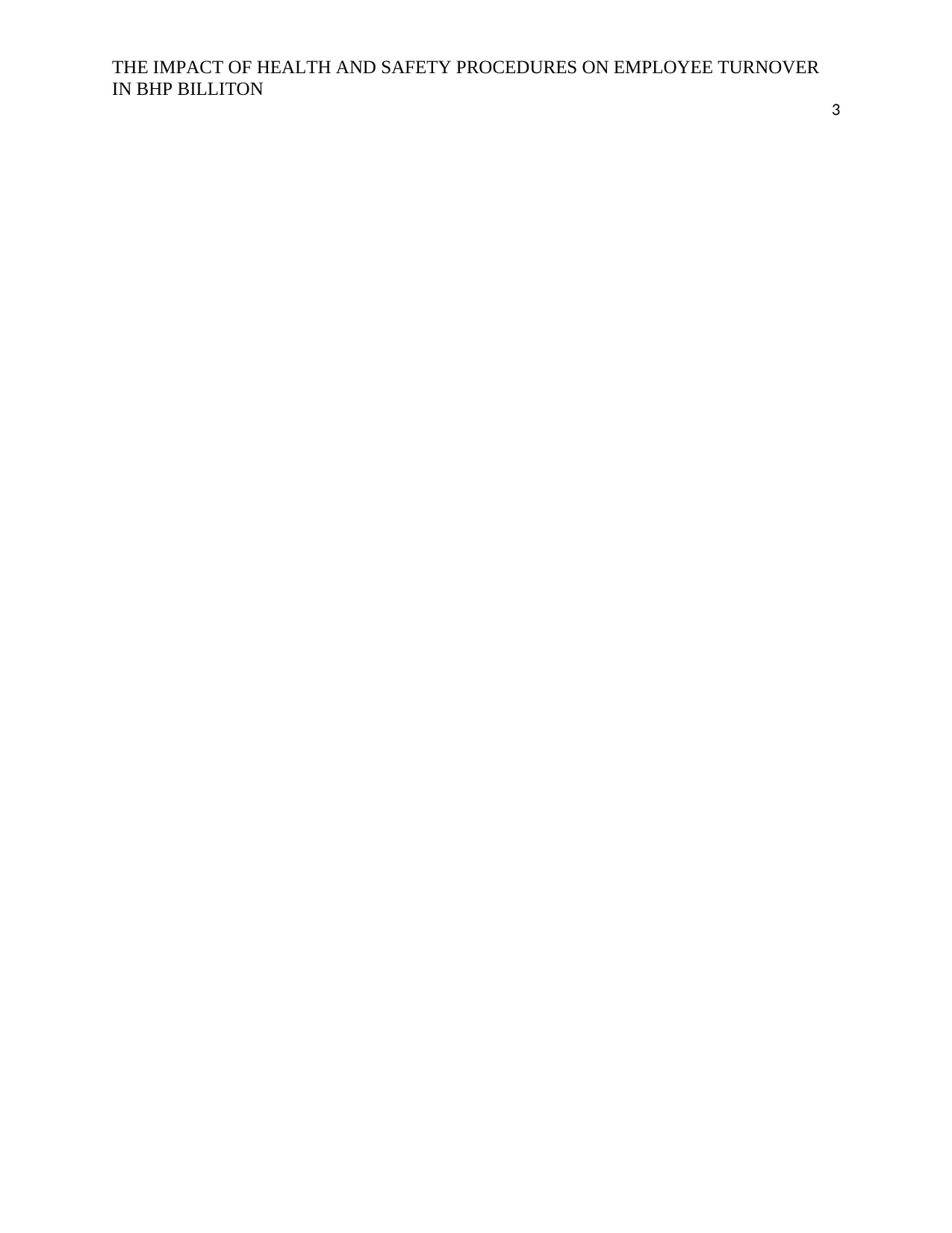
THE IMPACT OF HEALTH AND SAFETY PROCEDURES ON EMPLOYEE TURNOVER
IN BHP BILLITON
3
IN BHP BILLITON
3
Paraphrase This Document
Need a fresh take? Get an instant paraphrase of this document with our AI Paraphraser
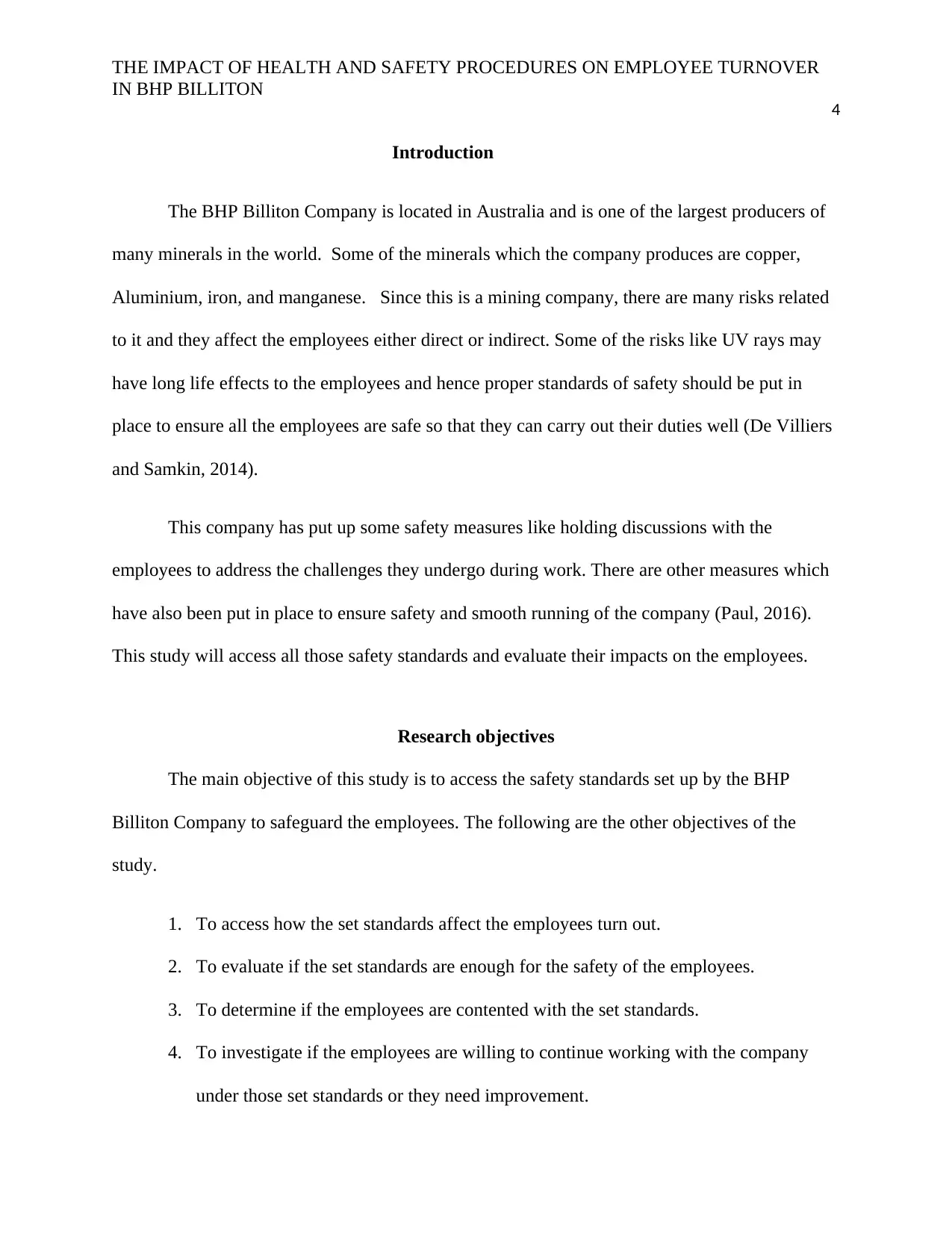
THE IMPACT OF HEALTH AND SAFETY PROCEDURES ON EMPLOYEE TURNOVER
IN BHP BILLITON
4
Introduction
The BHP Billiton Company is located in Australia and is one of the largest producers of
many minerals in the world. Some of the minerals which the company produces are copper,
Aluminium, iron, and manganese. Since this is a mining company, there are many risks related
to it and they affect the employees either direct or indirect. Some of the risks like UV rays may
have long life effects to the employees and hence proper standards of safety should be put in
place to ensure all the employees are safe so that they can carry out their duties well (De Villiers
and Samkin, 2014).
This company has put up some safety measures like holding discussions with the
employees to address the challenges they undergo during work. There are other measures which
have also been put in place to ensure safety and smooth running of the company (Paul, 2016).
This study will access all those safety standards and evaluate their impacts on the employees.
Research objectives
The main objective of this study is to access the safety standards set up by the BHP
Billiton Company to safeguard the employees. The following are the other objectives of the
study.
1. To access how the set standards affect the employees turn out.
2. To evaluate if the set standards are enough for the safety of the employees.
3. To determine if the employees are contented with the set standards.
4. To investigate if the employees are willing to continue working with the company
under those set standards or they need improvement.
IN BHP BILLITON
4
Introduction
The BHP Billiton Company is located in Australia and is one of the largest producers of
many minerals in the world. Some of the minerals which the company produces are copper,
Aluminium, iron, and manganese. Since this is a mining company, there are many risks related
to it and they affect the employees either direct or indirect. Some of the risks like UV rays may
have long life effects to the employees and hence proper standards of safety should be put in
place to ensure all the employees are safe so that they can carry out their duties well (De Villiers
and Samkin, 2014).
This company has put up some safety measures like holding discussions with the
employees to address the challenges they undergo during work. There are other measures which
have also been put in place to ensure safety and smooth running of the company (Paul, 2016).
This study will access all those safety standards and evaluate their impacts on the employees.
Research objectives
The main objective of this study is to access the safety standards set up by the BHP
Billiton Company to safeguard the employees. The following are the other objectives of the
study.
1. To access how the set standards affect the employees turn out.
2. To evaluate if the set standards are enough for the safety of the employees.
3. To determine if the employees are contented with the set standards.
4. To investigate if the employees are willing to continue working with the company
under those set standards or they need improvement.
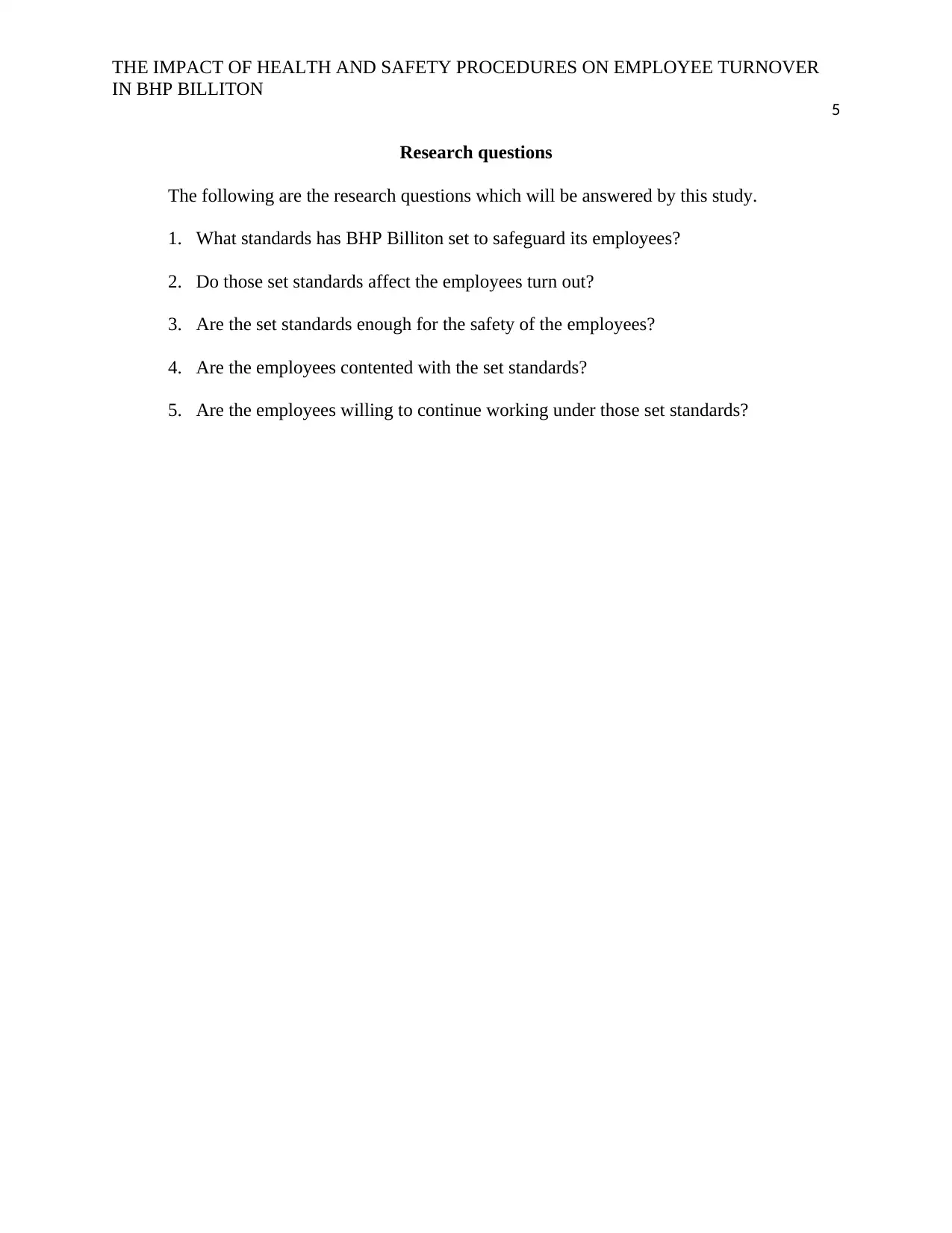
THE IMPACT OF HEALTH AND SAFETY PROCEDURES ON EMPLOYEE TURNOVER
IN BHP BILLITON
5
Research questions
The following are the research questions which will be answered by this study.
1. What standards has BHP Billiton set to safeguard its employees?
2. Do those set standards affect the employees turn out?
3. Are the set standards enough for the safety of the employees?
4. Are the employees contented with the set standards?
5. Are the employees willing to continue working under those set standards?
IN BHP BILLITON
5
Research questions
The following are the research questions which will be answered by this study.
1. What standards has BHP Billiton set to safeguard its employees?
2. Do those set standards affect the employees turn out?
3. Are the set standards enough for the safety of the employees?
4. Are the employees contented with the set standards?
5. Are the employees willing to continue working under those set standards?
⊘ This is a preview!⊘
Do you want full access?
Subscribe today to unlock all pages.

Trusted by 1+ million students worldwide
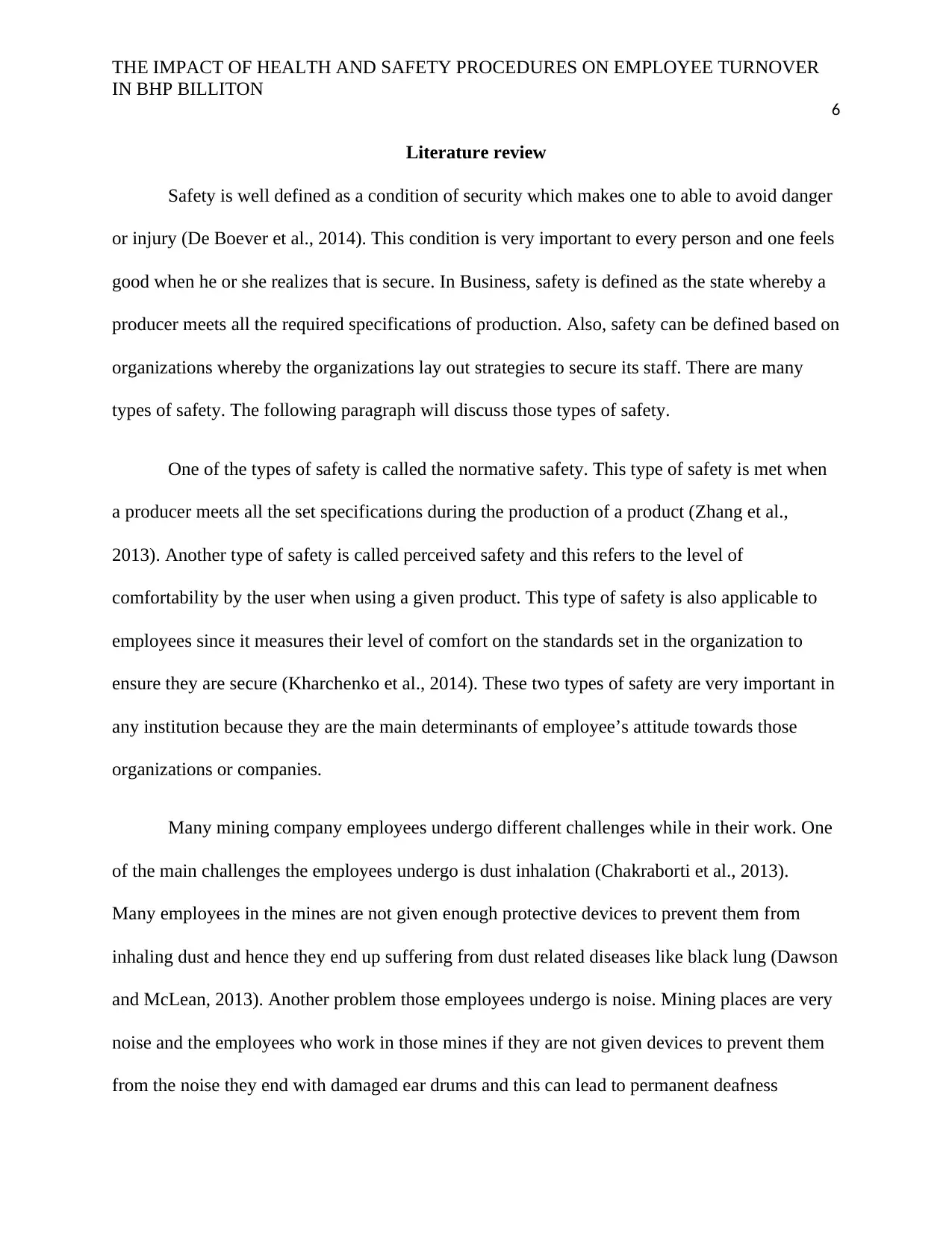
THE IMPACT OF HEALTH AND SAFETY PROCEDURES ON EMPLOYEE TURNOVER
IN BHP BILLITON
6
Literature review
Safety is well defined as a condition of security which makes one to able to avoid danger
or injury (De Boever et al., 2014). This condition is very important to every person and one feels
good when he or she realizes that is secure. In Business, safety is defined as the state whereby a
producer meets all the required specifications of production. Also, safety can be defined based on
organizations whereby the organizations lay out strategies to secure its staff. There are many
types of safety. The following paragraph will discuss those types of safety.
One of the types of safety is called the normative safety. This type of safety is met when
a producer meets all the set specifications during the production of a product (Zhang et al.,
2013). Another type of safety is called perceived safety and this refers to the level of
comfortability by the user when using a given product. This type of safety is also applicable to
employees since it measures their level of comfort on the standards set in the organization to
ensure they are secure (Kharchenko et al., 2014). These two types of safety are very important in
any institution because they are the main determinants of employee’s attitude towards those
organizations or companies.
Many mining company employees undergo different challenges while in their work. One
of the main challenges the employees undergo is dust inhalation (Chakraborti et al., 2013).
Many employees in the mines are not given enough protective devices to prevent them from
inhaling dust and hence they end up suffering from dust related diseases like black lung (Dawson
and McLean, 2013). Another problem those employees undergo is noise. Mining places are very
noise and the employees who work in those mines if they are not given devices to prevent them
from the noise they end with damaged ear drums and this can lead to permanent deafness
IN BHP BILLITON
6
Literature review
Safety is well defined as a condition of security which makes one to able to avoid danger
or injury (De Boever et al., 2014). This condition is very important to every person and one feels
good when he or she realizes that is secure. In Business, safety is defined as the state whereby a
producer meets all the required specifications of production. Also, safety can be defined based on
organizations whereby the organizations lay out strategies to secure its staff. There are many
types of safety. The following paragraph will discuss those types of safety.
One of the types of safety is called the normative safety. This type of safety is met when
a producer meets all the set specifications during the production of a product (Zhang et al.,
2013). Another type of safety is called perceived safety and this refers to the level of
comfortability by the user when using a given product. This type of safety is also applicable to
employees since it measures their level of comfort on the standards set in the organization to
ensure they are secure (Kharchenko et al., 2014). These two types of safety are very important in
any institution because they are the main determinants of employee’s attitude towards those
organizations or companies.
Many mining company employees undergo different challenges while in their work. One
of the main challenges the employees undergo is dust inhalation (Chakraborti et al., 2013).
Many employees in the mines are not given enough protective devices to prevent them from
inhaling dust and hence they end up suffering from dust related diseases like black lung (Dawson
and McLean, 2013). Another problem those employees undergo is noise. Mining places are very
noise and the employees who work in those mines if they are not given devices to prevent them
from the noise they end with damaged ear drums and this can lead to permanent deafness
Paraphrase This Document
Need a fresh take? Get an instant paraphrase of this document with our AI Paraphraser
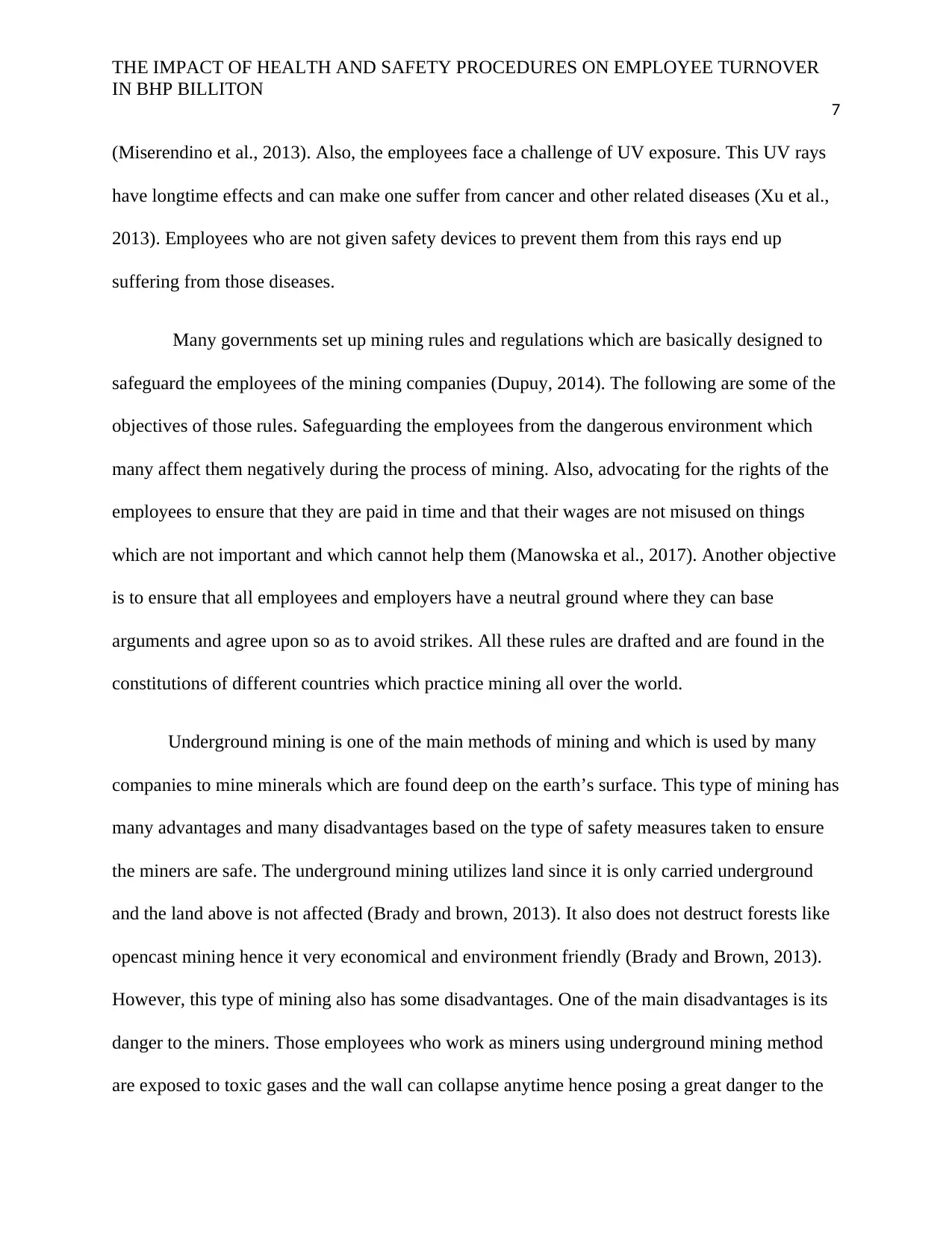
THE IMPACT OF HEALTH AND SAFETY PROCEDURES ON EMPLOYEE TURNOVER
IN BHP BILLITON
7
(Miserendino et al., 2013). Also, the employees face a challenge of UV exposure. This UV rays
have longtime effects and can make one suffer from cancer and other related diseases (Xu et al.,
2013). Employees who are not given safety devices to prevent them from this rays end up
suffering from those diseases.
Many governments set up mining rules and regulations which are basically designed to
safeguard the employees of the mining companies (Dupuy, 2014). The following are some of the
objectives of those rules. Safeguarding the employees from the dangerous environment which
many affect them negatively during the process of mining. Also, advocating for the rights of the
employees to ensure that they are paid in time and that their wages are not misused on things
which are not important and which cannot help them (Manowska et al., 2017). Another objective
is to ensure that all employees and employers have a neutral ground where they can base
arguments and agree upon so as to avoid strikes. All these rules are drafted and are found in the
constitutions of different countries which practice mining all over the world.
Underground mining is one of the main methods of mining and which is used by many
companies to mine minerals which are found deep on the earth’s surface. This type of mining has
many advantages and many disadvantages based on the type of safety measures taken to ensure
the miners are safe. The underground mining utilizes land since it is only carried underground
and the land above is not affected (Brady and brown, 2013). It also does not destruct forests like
opencast mining hence it very economical and environment friendly (Brady and Brown, 2013).
However, this type of mining also has some disadvantages. One of the main disadvantages is its
danger to the miners. Those employees who work as miners using underground mining method
are exposed to toxic gases and the wall can collapse anytime hence posing a great danger to the
IN BHP BILLITON
7
(Miserendino et al., 2013). Also, the employees face a challenge of UV exposure. This UV rays
have longtime effects and can make one suffer from cancer and other related diseases (Xu et al.,
2013). Employees who are not given safety devices to prevent them from this rays end up
suffering from those diseases.
Many governments set up mining rules and regulations which are basically designed to
safeguard the employees of the mining companies (Dupuy, 2014). The following are some of the
objectives of those rules. Safeguarding the employees from the dangerous environment which
many affect them negatively during the process of mining. Also, advocating for the rights of the
employees to ensure that they are paid in time and that their wages are not misused on things
which are not important and which cannot help them (Manowska et al., 2017). Another objective
is to ensure that all employees and employers have a neutral ground where they can base
arguments and agree upon so as to avoid strikes. All these rules are drafted and are found in the
constitutions of different countries which practice mining all over the world.
Underground mining is one of the main methods of mining and which is used by many
companies to mine minerals which are found deep on the earth’s surface. This type of mining has
many advantages and many disadvantages based on the type of safety measures taken to ensure
the miners are safe. The underground mining utilizes land since it is only carried underground
and the land above is not affected (Brady and brown, 2013). It also does not destruct forests like
opencast mining hence it very economical and environment friendly (Brady and Brown, 2013).
However, this type of mining also has some disadvantages. One of the main disadvantages is its
danger to the miners. Those employees who work as miners using underground mining method
are exposed to toxic gases and the wall can collapse anytime hence posing a great danger to the
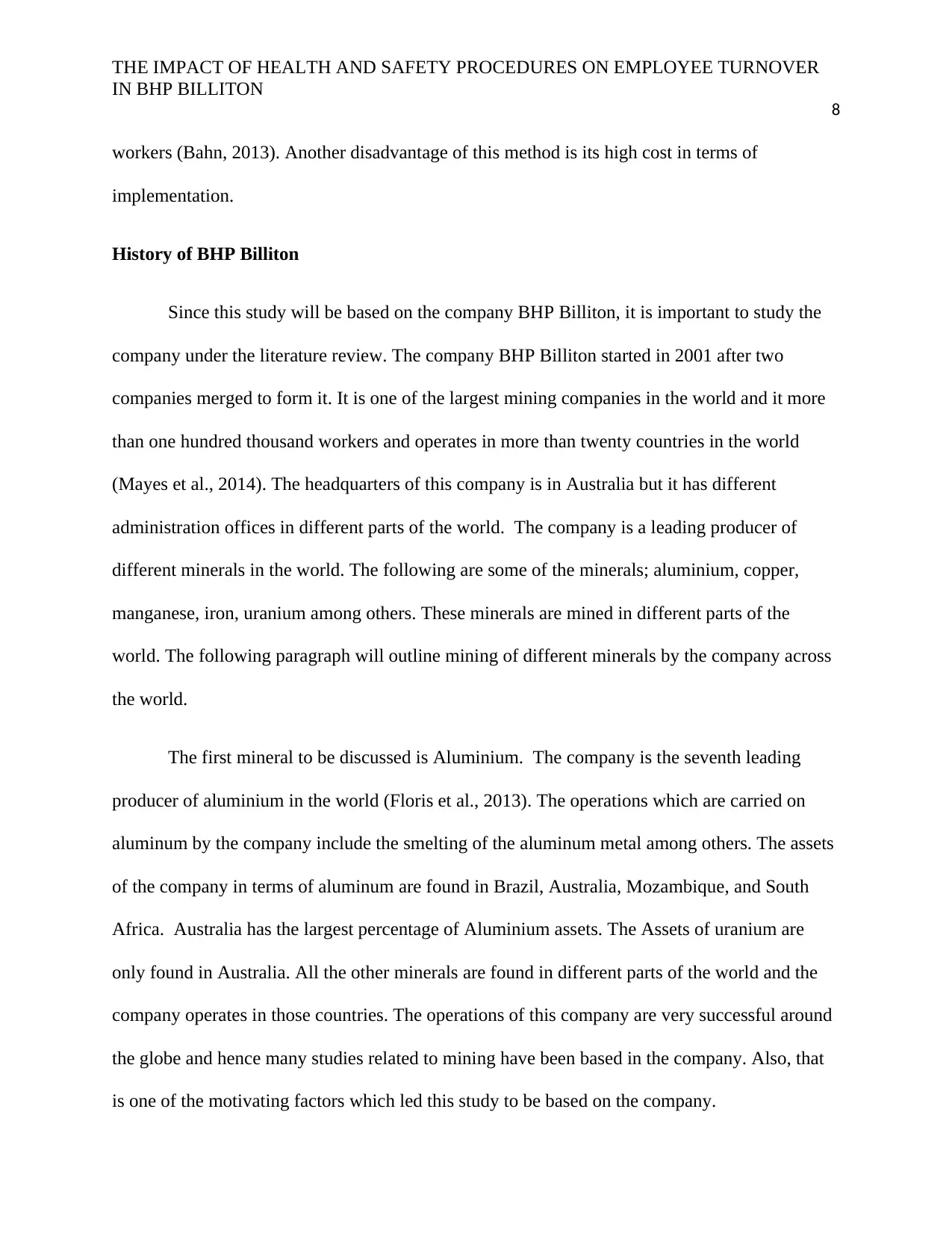
THE IMPACT OF HEALTH AND SAFETY PROCEDURES ON EMPLOYEE TURNOVER
IN BHP BILLITON
8
workers (Bahn, 2013). Another disadvantage of this method is its high cost in terms of
implementation.
History of BHP Billiton
Since this study will be based on the company BHP Billiton, it is important to study the
company under the literature review. The company BHP Billiton started in 2001 after two
companies merged to form it. It is one of the largest mining companies in the world and it more
than one hundred thousand workers and operates in more than twenty countries in the world
(Mayes et al., 2014). The headquarters of this company is in Australia but it has different
administration offices in different parts of the world. The company is a leading producer of
different minerals in the world. The following are some of the minerals; aluminium, copper,
manganese, iron, uranium among others. These minerals are mined in different parts of the
world. The following paragraph will outline mining of different minerals by the company across
the world.
The first mineral to be discussed is Aluminium. The company is the seventh leading
producer of aluminium in the world (Floris et al., 2013). The operations which are carried on
aluminum by the company include the smelting of the aluminum metal among others. The assets
of the company in terms of aluminum are found in Brazil, Australia, Mozambique, and South
Africa. Australia has the largest percentage of Aluminium assets. The Assets of uranium are
only found in Australia. All the other minerals are found in different parts of the world and the
company operates in those countries. The operations of this company are very successful around
the globe and hence many studies related to mining have been based in the company. Also, that
is one of the motivating factors which led this study to be based on the company.
IN BHP BILLITON
8
workers (Bahn, 2013). Another disadvantage of this method is its high cost in terms of
implementation.
History of BHP Billiton
Since this study will be based on the company BHP Billiton, it is important to study the
company under the literature review. The company BHP Billiton started in 2001 after two
companies merged to form it. It is one of the largest mining companies in the world and it more
than one hundred thousand workers and operates in more than twenty countries in the world
(Mayes et al., 2014). The headquarters of this company is in Australia but it has different
administration offices in different parts of the world. The company is a leading producer of
different minerals in the world. The following are some of the minerals; aluminium, copper,
manganese, iron, uranium among others. These minerals are mined in different parts of the
world. The following paragraph will outline mining of different minerals by the company across
the world.
The first mineral to be discussed is Aluminium. The company is the seventh leading
producer of aluminium in the world (Floris et al., 2013). The operations which are carried on
aluminum by the company include the smelting of the aluminum metal among others. The assets
of the company in terms of aluminum are found in Brazil, Australia, Mozambique, and South
Africa. Australia has the largest percentage of Aluminium assets. The Assets of uranium are
only found in Australia. All the other minerals are found in different parts of the world and the
company operates in those countries. The operations of this company are very successful around
the globe and hence many studies related to mining have been based in the company. Also, that
is one of the motivating factors which led this study to be based on the company.
⊘ This is a preview!⊘
Do you want full access?
Subscribe today to unlock all pages.

Trusted by 1+ million students worldwide
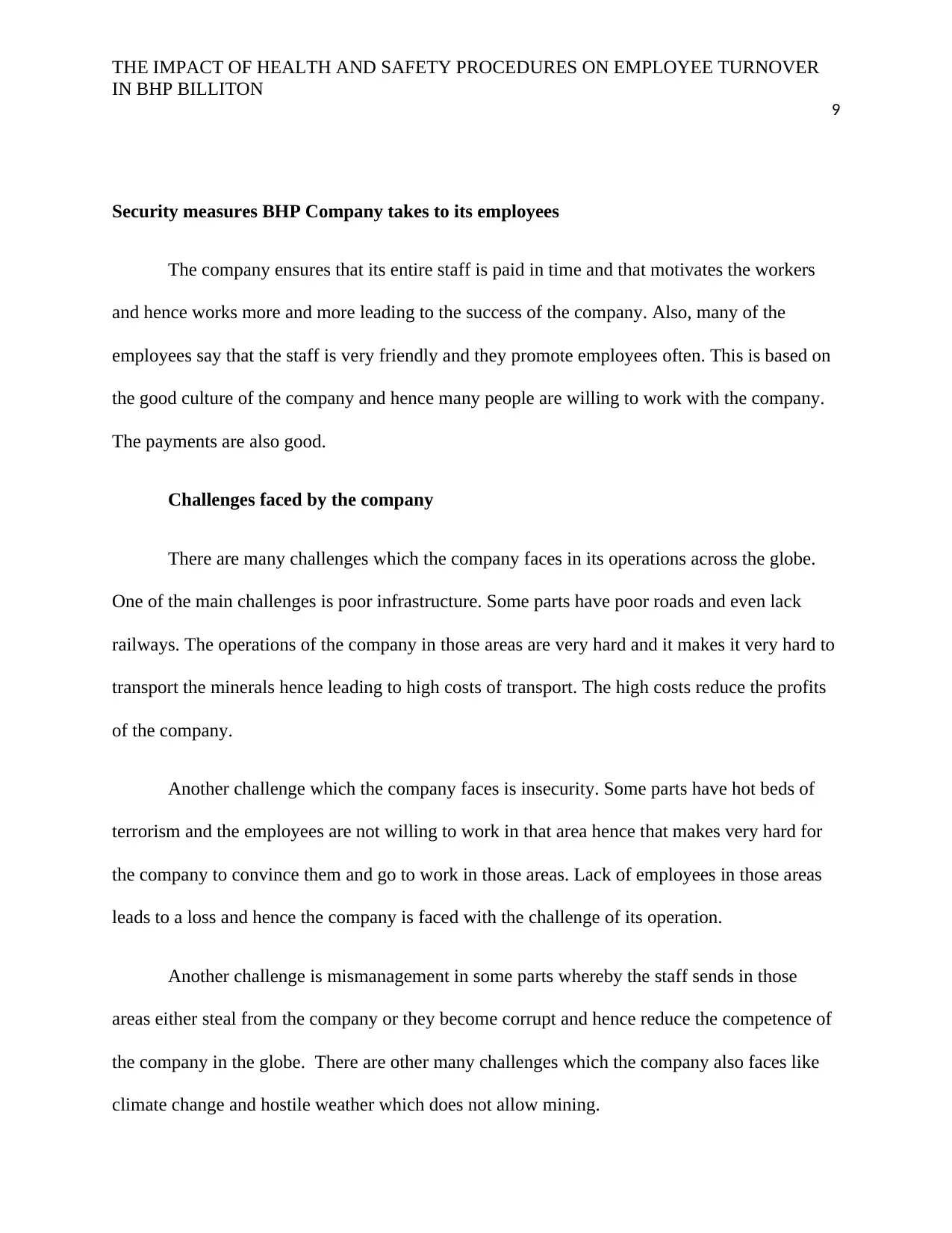
THE IMPACT OF HEALTH AND SAFETY PROCEDURES ON EMPLOYEE TURNOVER
IN BHP BILLITON
9
Security measures BHP Company takes to its employees
The company ensures that its entire staff is paid in time and that motivates the workers
and hence works more and more leading to the success of the company. Also, many of the
employees say that the staff is very friendly and they promote employees often. This is based on
the good culture of the company and hence many people are willing to work with the company.
The payments are also good.
Challenges faced by the company
There are many challenges which the company faces in its operations across the globe.
One of the main challenges is poor infrastructure. Some parts have poor roads and even lack
railways. The operations of the company in those areas are very hard and it makes it very hard to
transport the minerals hence leading to high costs of transport. The high costs reduce the profits
of the company.
Another challenge which the company faces is insecurity. Some parts have hot beds of
terrorism and the employees are not willing to work in that area hence that makes very hard for
the company to convince them and go to work in those areas. Lack of employees in those areas
leads to a loss and hence the company is faced with the challenge of its operation.
Another challenge is mismanagement in some parts whereby the staff sends in those
areas either steal from the company or they become corrupt and hence reduce the competence of
the company in the globe. There are other many challenges which the company also faces like
climate change and hostile weather which does not allow mining.
IN BHP BILLITON
9
Security measures BHP Company takes to its employees
The company ensures that its entire staff is paid in time and that motivates the workers
and hence works more and more leading to the success of the company. Also, many of the
employees say that the staff is very friendly and they promote employees often. This is based on
the good culture of the company and hence many people are willing to work with the company.
The payments are also good.
Challenges faced by the company
There are many challenges which the company faces in its operations across the globe.
One of the main challenges is poor infrastructure. Some parts have poor roads and even lack
railways. The operations of the company in those areas are very hard and it makes it very hard to
transport the minerals hence leading to high costs of transport. The high costs reduce the profits
of the company.
Another challenge which the company faces is insecurity. Some parts have hot beds of
terrorism and the employees are not willing to work in that area hence that makes very hard for
the company to convince them and go to work in those areas. Lack of employees in those areas
leads to a loss and hence the company is faced with the challenge of its operation.
Another challenge is mismanagement in some parts whereby the staff sends in those
areas either steal from the company or they become corrupt and hence reduce the competence of
the company in the globe. There are other many challenges which the company also faces like
climate change and hostile weather which does not allow mining.
Paraphrase This Document
Need a fresh take? Get an instant paraphrase of this document with our AI Paraphraser
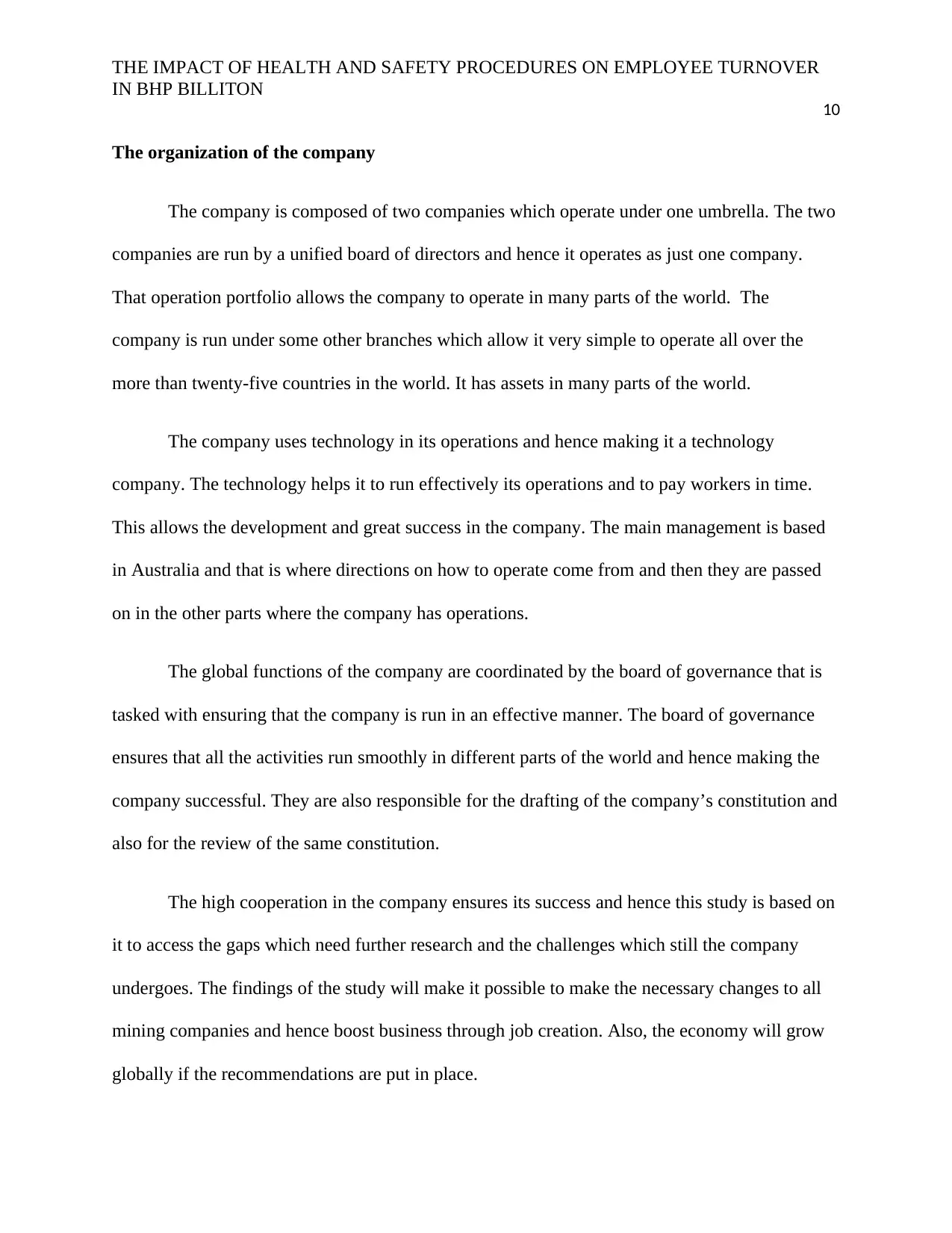
THE IMPACT OF HEALTH AND SAFETY PROCEDURES ON EMPLOYEE TURNOVER
IN BHP BILLITON
10
The organization of the company
The company is composed of two companies which operate under one umbrella. The two
companies are run by a unified board of directors and hence it operates as just one company.
That operation portfolio allows the company to operate in many parts of the world. The
company is run under some other branches which allow it very simple to operate all over the
more than twenty-five countries in the world. It has assets in many parts of the world.
The company uses technology in its operations and hence making it a technology
company. The technology helps it to run effectively its operations and to pay workers in time.
This allows the development and great success in the company. The main management is based
in Australia and that is where directions on how to operate come from and then they are passed
on in the other parts where the company has operations.
The global functions of the company are coordinated by the board of governance that is
tasked with ensuring that the company is run in an effective manner. The board of governance
ensures that all the activities run smoothly in different parts of the world and hence making the
company successful. They are also responsible for the drafting of the company’s constitution and
also for the review of the same constitution.
The high cooperation in the company ensures its success and hence this study is based on
it to access the gaps which need further research and the challenges which still the company
undergoes. The findings of the study will make it possible to make the necessary changes to all
mining companies and hence boost business through job creation. Also, the economy will grow
globally if the recommendations are put in place.
IN BHP BILLITON
10
The organization of the company
The company is composed of two companies which operate under one umbrella. The two
companies are run by a unified board of directors and hence it operates as just one company.
That operation portfolio allows the company to operate in many parts of the world. The
company is run under some other branches which allow it very simple to operate all over the
more than twenty-five countries in the world. It has assets in many parts of the world.
The company uses technology in its operations and hence making it a technology
company. The technology helps it to run effectively its operations and to pay workers in time.
This allows the development and great success in the company. The main management is based
in Australia and that is where directions on how to operate come from and then they are passed
on in the other parts where the company has operations.
The global functions of the company are coordinated by the board of governance that is
tasked with ensuring that the company is run in an effective manner. The board of governance
ensures that all the activities run smoothly in different parts of the world and hence making the
company successful. They are also responsible for the drafting of the company’s constitution and
also for the review of the same constitution.
The high cooperation in the company ensures its success and hence this study is based on
it to access the gaps which need further research and the challenges which still the company
undergoes. The findings of the study will make it possible to make the necessary changes to all
mining companies and hence boost business through job creation. Also, the economy will grow
globally if the recommendations are put in place.
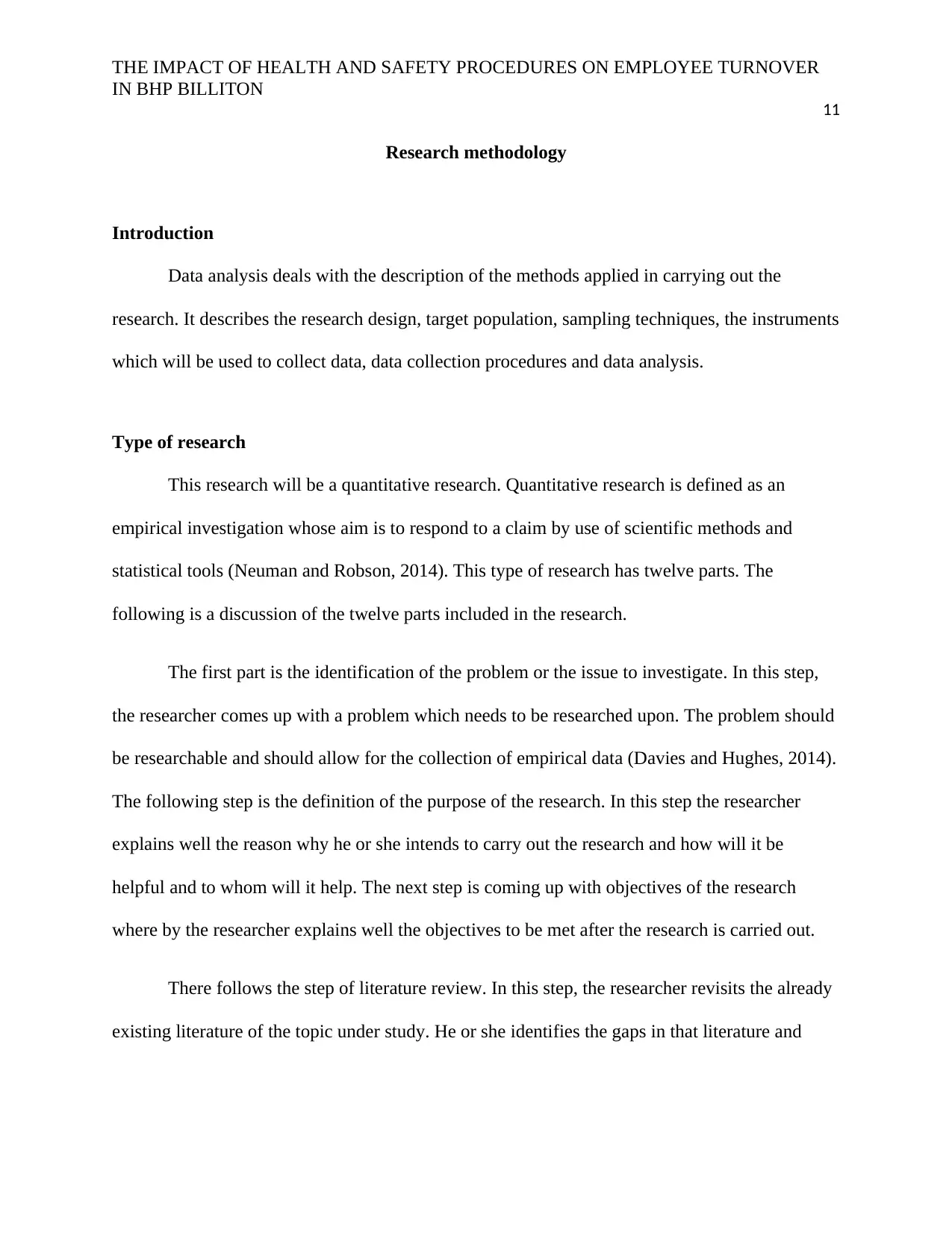
THE IMPACT OF HEALTH AND SAFETY PROCEDURES ON EMPLOYEE TURNOVER
IN BHP BILLITON
11
Research methodology
Introduction
Data analysis deals with the description of the methods applied in carrying out the
research. It describes the research design, target population, sampling techniques, the instruments
which will be used to collect data, data collection procedures and data analysis.
Type of research
This research will be a quantitative research. Quantitative research is defined as an
empirical investigation whose aim is to respond to a claim by use of scientific methods and
statistical tools (Neuman and Robson, 2014). This type of research has twelve parts. The
following is a discussion of the twelve parts included in the research.
The first part is the identification of the problem or the issue to investigate. In this step,
the researcher comes up with a problem which needs to be researched upon. The problem should
be researchable and should allow for the collection of empirical data (Davies and Hughes, 2014).
The following step is the definition of the purpose of the research. In this step the researcher
explains well the reason why he or she intends to carry out the research and how will it be
helpful and to whom will it help. The next step is coming up with objectives of the research
where by the researcher explains well the objectives to be met after the research is carried out.
There follows the step of literature review. In this step, the researcher revisits the already
existing literature of the topic under study. He or she identifies the gaps in that literature and
IN BHP BILLITON
11
Research methodology
Introduction
Data analysis deals with the description of the methods applied in carrying out the
research. It describes the research design, target population, sampling techniques, the instruments
which will be used to collect data, data collection procedures and data analysis.
Type of research
This research will be a quantitative research. Quantitative research is defined as an
empirical investigation whose aim is to respond to a claim by use of scientific methods and
statistical tools (Neuman and Robson, 2014). This type of research has twelve parts. The
following is a discussion of the twelve parts included in the research.
The first part is the identification of the problem or the issue to investigate. In this step,
the researcher comes up with a problem which needs to be researched upon. The problem should
be researchable and should allow for the collection of empirical data (Davies and Hughes, 2014).
The following step is the definition of the purpose of the research. In this step the researcher
explains well the reason why he or she intends to carry out the research and how will it be
helpful and to whom will it help. The next step is coming up with objectives of the research
where by the researcher explains well the objectives to be met after the research is carried out.
There follows the step of literature review. In this step, the researcher revisits the already
existing literature of the topic under study. He or she identifies the gaps in that literature and
⊘ This is a preview!⊘
Do you want full access?
Subscribe today to unlock all pages.

Trusted by 1+ million students worldwide
1 out of 25
Related Documents
Your All-in-One AI-Powered Toolkit for Academic Success.
+13062052269
info@desklib.com
Available 24*7 on WhatsApp / Email
![[object Object]](/_next/static/media/star-bottom.7253800d.svg)
Unlock your academic potential
Copyright © 2020–2025 A2Z Services. All Rights Reserved. Developed and managed by ZUCOL.





